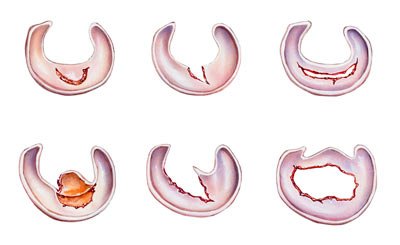What is a meniscus injury?
 Usually meniscus injuries occur in the form of a meniscal tears. These can be acute, when the tear is due to trauma and usually consists of a forceful twist or rotation to the knee such as aggressive pivoting, kneeling or deep squatting. Around one third of all meniscal tears are believed to be acute1. Tears can also be chronic (degenerative) and these usually occur in older patients when the meniscus has weakened and generally undergone a degeneration in mechanical properties becoming less elastic over time.
Usually meniscus injuries occur in the form of a meniscal tears. These can be acute, when the tear is due to trauma and usually consists of a forceful twist or rotation to the knee such as aggressive pivoting, kneeling or deep squatting. Around one third of all meniscal tears are believed to be acute1. Tears can also be chronic (degenerative) and these usually occur in older patients when the meniscus has weakened and generally undergone a degeneration in mechanical properties becoming less elastic over time.
How common?
Meniscal tear is the most common knee problem treated surgically2 with over 1.7 million meniscal injuries in the EU and the US being treated each year. The location and pattern of these tears determines ability of the tear to heal (low or no blood supply in some zones of the meniscus means healing can sometimes be difficult or impossible).
Generally, the medial meniscus is more prone to injury (trauma, sports injuries) compared to the lateral meniscus although lateral meniscectomy is associated with a higher risk of developing tibiofemoral osteoarthritis and a greater rate of cartilage degradation3.
What are the consequences of a meniscal tear?
 In the short term, meniscal tears are associated with pain, stiffness, swelling, locking of knee and restricted motion of the knee2. In the long term, meniscal tears or partial/complete removal of the meniscus causes a change in knee biomechanics leading to articular cartilage degeneration and ultimately osteoarthritis4.
In the short term, meniscal tears are associated with pain, stiffness, swelling, locking of knee and restricted motion of the knee2. In the long term, meniscal tears or partial/complete removal of the meniscus causes a change in knee biomechanics leading to articular cartilage degeneration and ultimately osteoarthritis4.
- Maffulli et al. 2010. Meniscal Tears. Open Access Journal of Sports Medicine, v.1, pp.45–54
- American Academy of Orthopaedic Surgeons (AAOS)
- Lee et al. 2000. The meniscus: basic science and clinical implications. Operative Techniques in Orthopaedics. 2000;10(3), pp.162–168.
- McDermott et al. 2006. The consequences of meniscectomy. The Journal of Bone & Joint Surgery. Br, v.88(12), pp.1549-1556.
